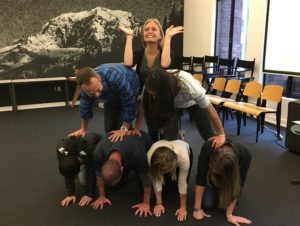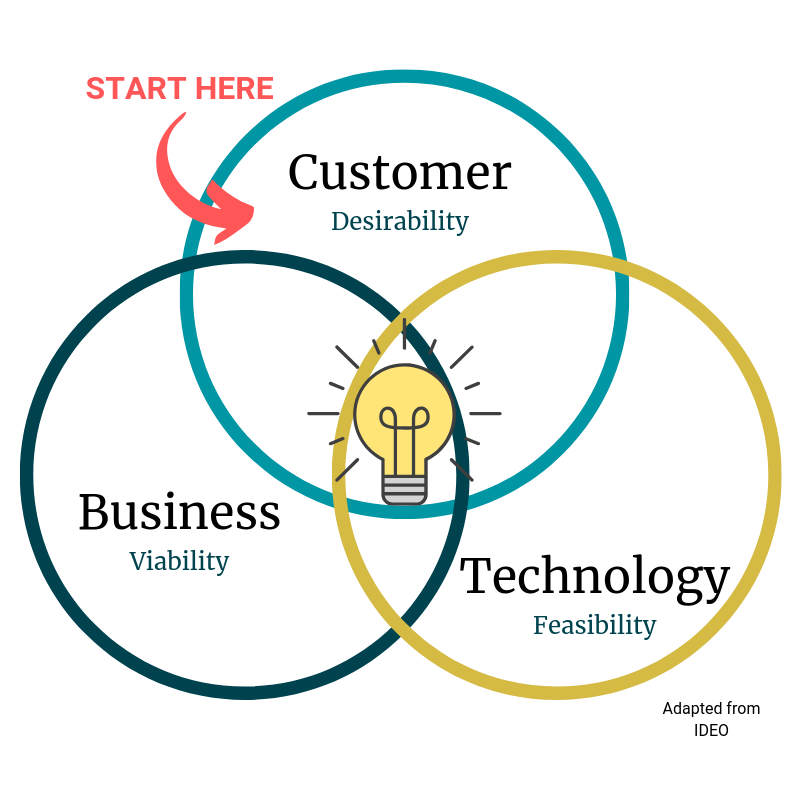At one point in my career in Big 4 consulting, I was in an innovation strategy meeting with leadership and one leader framed our innovation goal by asking, “How can we do more with less?” Beyond this being a cliche phrase at the time, this was also the moment I realized the big problem with how companies — especially large ones — view and pursue innovation: The same way they view any other business optimization effort, as a process of extracting value from an existing system.
Unfortunately, I’ve encountered the same error in strategic perspective in my post-Big 4 career as an innovation consultant. Too many organizations have innovation backward: Effective innovators aren’t seeking to do MORE with less, they are seeking to do BETTER. They see innovation as a way of creating new value and possibilities, not merely extracting incremental value. They work with an abundance mindset (“creation”) rather than one of scarcity (“extraction”).
When you approach innovation as a means to squeeze pennies, seconds, or even people out of your existing business processes, whatever you’re doing can (and will) easily be copied by your competitors. If you’re not creating new value, you’re not developing strategic advantages. In short, you’re not really innovating.
“Most big, established corporations make their profits by squeezing more out of the same. Business Schools basically teach the analytics of efficiency. Creativity is about finding opportunity in uncertainty. The task ahead is to amplify our creative capacities to find new opportunities that generate big profits and jobs.” – Bruce Nussbaum
By now you might be thinking, “Oh wait, we’ve been doing innovation all wrong!”, which could be true, or you’re thinking “We need to be doing real innovation NOW,” which is definitely true. Moving forward, consider taking a Mindhatch approach to innovation to avoid the “do more with less” trap.
Start With the Customer Need by Using Design Thinking
Design thinking (also known as human-centered design) is core to our approach to innovation. A huge value driver of design thinking is its emphasis on putting yourself in your customers’ shoes to truly understand their needs, wants, and problems. This allows you to validate that what you’re creating is in response to a true customer need. Alternatively, when you start instead with the constraints of your existing business or technology and what’s possible within your current systems, you’re going to end up in incremental extraction mode rather than on a path to value creation.
In 2004, Bank of America partnered with IDEO to figure out how to get more people to open savings accounts. True to the process of design thinking, the IDEO team started by talking to families and individuals about how they spend and save money. It was in these conversations that a pattern emerged: When balancing their checkbooks, some interviewees rounded up each check amount to make addition easier and create a small buffer between spending and saving.
Based on this insight and the fact that many families have great difficulty saving money, Bank of America’s Keep the Change program was born: “People could enroll in a savings account that would round up purchases made with debit cards. Then, the overage would be transferred to a savings account automatically. In addition, the bank would match the money transferred to savings to a certain dollar amount.
Since the program’s launch in 2005, the program has been a big success — and it all started with a clearly defined customer need that was knowable only by meeting customers where they were to understand their experiences. More than 12.3 million customers have participated and they’ve saved more than 2 billion dollars!
Focus on Organizational Culture
You can’t achieve fresh value unless you’ve set the right conditions. In the workplace, such conditions are defined by your organizational culture. We’ve found that design thinking and organizational improv are both effective tools in driving organizational change toward cultures that champion collaboration, ideation, and productive failure. We also encourage clients to consider how they incentivize (or disincentivize) their optimal culture by revising competency models, performance reviews processes, etc. However, these things are not the only path to strong organization cultures: The how is less important than the result and it will look different for each organization.
Bridgewater Associates, one of the most successful hedge funds in the history of the industry, is a prime example of how important culture is for innovation. The company describes its culture as an idea meritocracy where the best ideas, no matter where they come from, win.
In his book Originals, organizational psychologist Adam Grant studied Bridgewater for this very reason: “In the investment world, you can only make money if you think different from everyone else. Bridgewater has prevented groupthink by inviting dissenting opinions from every employee in the company. When employees share independent viewpoints instead of conforming to the majority, there’s a much higher chance that Bridgewater will make investment decisions no one else has considered and recognize financial trends no one else has discerned. That makes it possible to be right when the rest of the market is wrong.”
While making investment decisions that no one else is making may not sound innovative, it is for the financial industry in which Bridgewater belongs. From these decisions, the company has built innovative financial products (funds) that have in turn created incredible returns (value) for their customers — and its bottom line.
Such a strong organizational culture doesn’t happen on its own — it needs to be created and nurtured. Bridgewater invests heavily in its organizational culture: It has documented its philosophy into more than 200 principles, which are used daily. New team members are hired based on cultural contribution (rather than cultural fit) and are trained in a military-inspired boot camp. Lastly, the company developed and uses its own tools to help promote a culture of radical honesty and radical transparency.
“Our success occurred because we created a real idea meritocracy in which the goal was to have meaningful work and meaningful relationships and the way we went after them was through radical truthfulness and radical transparency.” – Ray Dalio, Founder of Bridgewater Associates
Embrace the Power of Small Innovative Solutions
We often encounter the misperception that true innovation and creating new value requires disruption. It doesn’t. Small but smart and strategic changes can, and often do, create new and significant value. An important part of our innovation ethos at Mindhatch is that small changes can often add up to BIG impact.
Years ago executives at a major hotel chain spent a pretty penny trying to figure out how to get the elevators to move faster as a response to customer complaints that they were too slow. All the proposed solutions involved significant modifications to the elevators and adding more elevator banks — all of which were prohibitively costly fixes. Finally someone realized that the real problem wasn’t that the elevators were too slow but that the customers were bored waiting for them. The winning solution? Adding mirrors outside of elevator doors so people could look at themselves while they waited. The result? Much fewer complaints.
Set the Conditions for Expansive, Generative, and Divergent Thinking
Simultaneously ideating and passing judgment on those ideas is a sure way to kill creativity. So, one way that we encourage big and broad thinking is to put a hold on any evaluation and judgment until it’s absolutely necessary. Another way of saying this is that we separate divergent and convergent thinking, giving each their own time and place
A few years ago, the vice president of research and development at a construction materials company came to us for help. He was happy that he was getting 50 ideas from his team of 25 at each 2- to 3-hour brainstorming session he ran; yet he struggled to figure out what to do with those ideas once he had them.
First, I had to break it to him that 50 ideas from two to three hours of brainstorming was not good ROI — that’s only two ideas per person! Then we designed and delivered a day-and-a-half long ideation session with the same 25 employees. In that time, the group came up with more than one thousand ideas, we prioritized and down selected to just 25 of them, and we outlined next steps for their implementation.
To set the conditions for such abundant thinking we warmed everyone up with a divergent thinking exercise (like FIVE THINGS or 30 Circles, used organizational improv methods to avoid self-censoring, employed human centered methods to get participants seeing things from their customers’ point of view, and used a variety of stimuli for participants to engage in and explore ideas. We first opened the ideation floodgates with divergent thinking, and then surfaced the best ideas with convergent thinking.

Bring In Diverse Points of View
When crafting teams, big or small, we intentionally pull in people with diverse perspectives to prevent groupthink and lay the foundation for creative, out-of-the-box solutions to whatever problem we’re solving for. We may even intentionally decide to invite the biggest naysayer in the organization to keep us on point. Even when co-facilitating innovation sessions, we look for an outside partner who brings something to the table that we don’t.
Bringing together people of different backgrounds and expertise has become a key approach to solving challenging problems that both the private and public sectors face. For example, to improve the health outcomes from hospitals, communities and medical professionals are turning to social design, the design of relationships both visible and invisible, to improve the built environment of our healthcare spaces. One key principle of social design is to “seek input from people who don’t think like you.” For hospitals seeking to improve outcomes, this requires bringing in perspectives from patients and their families, doctors, administrators, engineers, designers, architects, and nurses. By doing so, they’re able to approach a challenge — such as how to reduce unnecessary Cesarean deliveries — holistically but also from different angles in order to develop new innovative solutions such as designing hospitals so that there are more labor rooms.
All too often companies try to innovate as a last resort: They’re in a bind, the economy is tanking, they’ve tried everything else, etc… But when your business is in trouble is not the time to start innovating. Innovation should be a part of how you do business, day in and day out, to protect your company’s longevity and ensure growth. Real innovation — where new value is created consistently — requires using practices and tools that encourage regular innovative thinking. Innovation isn’t something you do, rather it requires intentionally making the space and setting the conditions for it. Essentially, innovation is a process, one that results in fresh value. What company doesn’t want that?




Leave a Comment